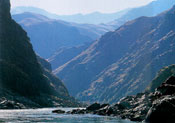
 |
| Hells Canyon. |
The portion of the Snake River from the Idaho-Washington border at Lewiston upstream to Hells Canyon Dam is 108 miles in length. The section from the Washington-Oregon border to Hells Canyon Dam flows through the deepest gorge in the United States in the Hells Canyon National Recreation Area. Forty miles of the river from the Washington-Oregon border to Big Canyon Creek is designated a "scenic" river under the Wild and Scenic Rivers System, and the remaining upper 32 miles is classified as "wild." Both the Idaho and Oregon sides of the river in the upper portions of the recreation area are bounded by wilderness. Legislation passed by Congress in 1989 prohibits the Federal Energy Regulatory Commission from issuing any licenses to develop new mainstem hydropower projects in the Snake River. Congressional intent also includes federally authorized projects.
River flows are controlled by Hells Canyon Dam and upstream storage. Daily water levels can fluctuate vertically 3 to 4 feet below Hells Canyon Dam. Quality of water passing through the canyon has improved substantially since the creation of the upriver impoundments. The reservoirs act as settling basins that enhance water quality.
The lower portion of the river near Lewiston is impounded by Lower Granite Dam which lies 40 miles below Lewiston. The reservoir extends above the towns of Lewiston and Clarkston, making the area an inland seaport.
The Snake River upstream to Hells Canyon Dam is the migration corridor for adult and juvenile anadromous fish moving to and from the Salmon, Imnaha, and Grande Ronde subbasins. Spring, summer, and fall chinook salmon, sockeye salmon, Pacific lamprey, and steelhead pass through this reach of the river. Fall chinook salmon also spawn in the mainstem of the Snake River. Most of the minor Snake River tributaries which are accessible to anadromous fish, such as Granite, Sheep, and Captain John creeks, are suitable for steelhead spawning and rearing.
Major resident game fish species found in the river include smallmouth bass, white sturgeon, channel catfish, and rainbow trout. The rainbow fishery is primarily supported by maintenance stocking. The present sturgeon fishery is nonconsumptive because of depressed populations. Sturgeon ranging to 9 feet have been caught in recent years.
The small tributaries in this reach of the Snake River drain from high forested areas through break lands to arid bottoms before entering the river. Many streams have a very steep gradient and are accessible to steelhead trout only in the lower reaches. The upper reaches of some of the larger streams, such as Granite and Sheep creeks, support populations of resident rainbow, cutthroat, and bull trout.